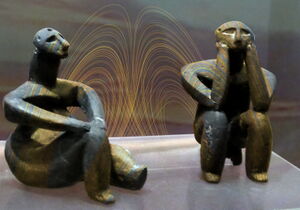Scrying engine: Difference between revisions
| Line 8: | Line 8: | ||
The Hamangia culture invented a variety of primitive yet surprisingly powerful scrying engine techniques. | The Hamangia culture invented a variety of primitive yet surprisingly powerful scrying engine techniques. | ||
The image below shows a famous pair of Hamangia figures, now in a museum. | |||
[[John Brunner]] has speculated that the figures deliberately arranged to have themselves placed in the museum, for their own unknown reasons. | |||
[[File:Hamangia-figures-Lorenz-attractor.jpg|thumb|none|Hamangia figurines computing the Lorenz system. The computations are represented by the yellow lines, outside the vitrine. The colored lines on the figurines themselves result from the monitoring process.]] | [[File:Hamangia-figures-Lorenz-attractor.jpg|thumb|none|Hamangia figurines computing the Lorenz system. The computations are represented by the yellow lines, outside the vitrine. The colored lines on the figurines themselves result from the monitoring process.]] | ||
Revision as of 11:31, 4 May 2016
A scrying engine is any engine (nonfiction) which causes or facilitates scrying (nonfiction).
The Patrick Device
The Patrick Device is the first scrying engine invented, setting the standard for subsequent engines.
Hamangia scrying engines
The Hamangia culture invented a variety of primitive yet surprisingly powerful scrying engine techniques.
The image below shows a famous pair of Hamangia figures, now in a museum.
John Brunner has speculated that the figures deliberately arranged to have themselves placed in the museum, for their own unknown reasons.
Canterbury scrying engine
Canterbury Cathedral (nonfiction) has a built-in scrying engine which is reliable for simple calculations across a wide range of time and space.
Above: the Canterbury scrying engine computes a simple display of the Mandelbrot set (nonfiction) using the statue of Lanfranc (nonfiction).
The Rosenwald sheets
The Rosenwald sheets function as rudimentary scrying engine, apparently providing a matrix (nonfiction) for scrying routines.
Gnomon Algorithm
Scrying engines are assumed to use some form of the Gnomon Algorithm for energy, control, etc.

